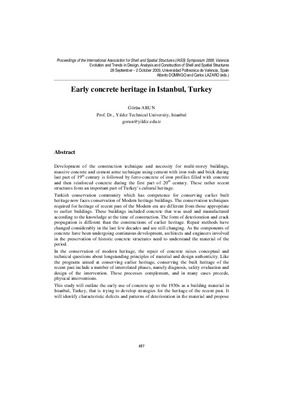JavaScript is disabled for your browser. Some features of this site may not work without it.
Buscar en RiuNet
Listar
Mi cuenta
Estadísticas
Ayuda RiuNet
Admin. UPV
Early concrete heritage in Istanbul, Turkey
Mostrar el registro sencillo del ítem
Ficheros en el ítem
| dc.contributor.author | ARUN, Görün
|
|
| dc.contributor.editor | Domingo Cabo, Alberto
|
es_ES |
| dc.contributor.editor | Lázaro Fernández, Carlos Manuel
|
es_ES |
| dc.date.accessioned | 2009-12-18T12:22:59Z | |
| dc.date.available | 2009-12-18T12:22:59Z | |
| dc.date.issued | 2009-12-18T12:22:59Z | |
| dc.identifier.isbn | 978-84-8363-461-5 | |
| dc.identifier.uri | http://hdl.handle.net/10251/6729 | |
| dc.description | p. 687-696 | en_EN |
| dc.description.abstract | Development of the construction technique and necessity for multi-storey buildings, massive concrete and cement arme technique using cement with iron rods and brick during last part of 19th century is followed by ferro-concrete of iron profiles filled with concrete and then reinforced concrete during the first part of 20th century. These rather recent structures form an important part of Turkey¿s cultural heritage. Turkish conservation community which has competence for conserving earlier built heritage now faces conservation of Modern heritage buildings. The conservation techniques required for heritage of recent past of the Modern era are different from those appropriate to earlier buildings. These buildings included concrete that was used and manufactured according to the knowledge at the time of construction. The form of deterioration and crack propagation is different than the constructions of earlier heritage. Repair methods have changed considerably in the last few decades and are still changing. As the components of concrete have been undergoing continuous development, architects and engineers involved in the preservation of historic concrete structures need to understand the material of the period. In the conservation of modern heritage, the repair of concrete raises conceptual and technical questions about longstanding principles of material and design authenticity. Like the programs aimed at conserving earlier heritage, conserving the built heritage of the recent past include a number of interrelated phases, namely diagnosis, safety evaluation and design of the intervention. These processes complement, and in many cases precede, physical interventions. This study will outline the early use of concrete up to the 1930s as a building material in Istanbul, Turkey, that is trying to develop strategies for the heritage of the recent past. It will identify characteristic defects and patterns of deterioration in the material and propose a set of evaluation procedures and conservation strategies for the preservation and repair of these structures. | en_EN |
| dc.language | Inglés | en_EN |
| dc.publisher | Editorial Universitat Politècnica de València | es_ES |
| dc.relation.ispartof | Symposium of the International Association for Shell and Spatial Structures (50th. 2009. Valencia). Evolution and Trends in Design, Analysis and Construction of Shell and Spatial Structures : Proceedings | en_EN |
| dc.rights | Reserva de todos los derechos | en_EN |
| dc.subject | Early concrete buildings in istanbul | en_EN |
| dc.subject | Preservation of early concrete buildings | en_EN |
| dc.subject | Ferro-concrete structure | en_EN |
| dc.title | Early concrete heritage in Istanbul, Turkey | en_EN |
| dc.type | Comunicación en congreso | en_EN |
| dc.rights.accessRights | Abierto | es_ES |
| dc.description.bibliographicCitation | Arun, G. (2009). Early concrete heritage in Istanbul, Turkey. Editorial Universitat Politècnica de València. http://hdl.handle.net/10251/6729 | es_ES |
| dc.relation.conferencename | Symposium of the International Association for Shell and Spatial Structures | es_ES |
| dc.relation.conferencedate | 2009 | es_ES |
| dc.relation.conferenceplace | Valencia | es_ES |






